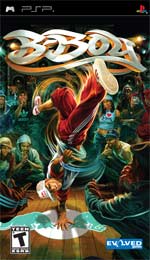Break a Virtual Leg
Breakdancing as a game concept is a novel concept, and B-Boy for the PSP illustrates just how well that idea can be realized. It’s not perfect and it doesn’t have much in the way of depth; in fact, it’s only a few notches above a novelty game, but it’s an original concept that deserves some praise and is recommended for those looking for a fresh gaming experience.
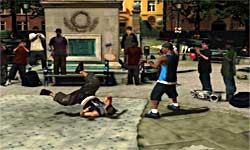
B-Boy for the PSP is not exactly new. It was originally released in ’06 in Europe, but available here only as an import, until now. It’s also available for the PS2, but I find that the game translates better to the PSP, although there are some issues with the icons, which can be a little difficult to see. The hundreds of motion-captured graphics and the good variety of tunes make B-Boy a solid package. It’s much easier to appreciate the production values on the PSP. But not all is sunshine and lollipops; the gameplay is somewhat shallow and redundant, the controls aren’t entirely comfortable to access, the camera angles can confuse and confound, and the load times are almost unbearable.
Beginning with a blank-slate character in the Career mode, your goal is to bring him or her from obscurity in the ‘hood to worldwide prominence (read: fame and fortune) through breakdancing competitions. As you rise through the ranks, you’ll earn money that can be used to upgrade your lifestyle, from the bling around your neck to the crib that shelters your body from the elements. You’ll also unlock more moves as you progress. These moves comprise the main structure of the gameplay. It’s an amalgam of games such as Street Fighter, Tony Hawk, and Dance Dance Revolution without the floor mat. Breakdancing vicariously through a video game is a hell of a lot safer than in real life.
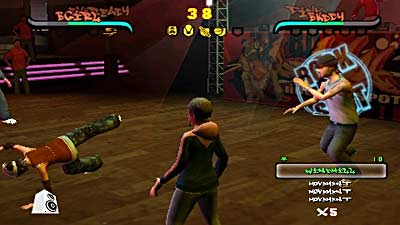
With the four face buttons, you’ll be able execute four main moves. The D-pad will allow you to modify each of these moves and access new ones that you pick up along the way. Even the shoulder buttons get in on the act, as they are used to balance your character during a headstand or “freeze.” It’s like a little mini-game where you have to balance a horizontal meter by pressing both shoulder buttons alternately to keep it centered. Like all the moves, if you screw up or leave too much of a gap, you’ll literally fall on your face. You have 45 seconds to do your best routine, after which your opponent will have the same amount of time to perform his or her routine. There is a lot of waiting around in this game, not only the load times but having to watch the competition do their routines. There’s something not quite right about watching the A.I. go through its solo performance. That’s something that is better suited for multiplayer.
Main moves include the windmill, six step, top rock, and freeze. Points are awarded for the precise execution of these moves in relation to timing, as well as the way they are linked together in terms of cohesion and overall smoothness. These two categories are known as Foundation and Flow, and you’ll earn medals for good performances in both. Underneath the dancer’s feet is a circle with a number of grooves, similar to spokes on a wheel. You must select your moves when the grooves line up with the colored marker. A certain amount of feel is necessary to excel in this game, as is a certain amount of rhythm, but not so much to the beat of the music as to the timing of the circular spinning icon. Learning to actually ignore the beat of the music and replace it with another independent form of syncopation requires practice. But all the practice in the world won’t help to keep the circular rhythm icon in view at all times thanks to the MTV-inspired camera cut-aways; you have to keep your internal metronome ticking.
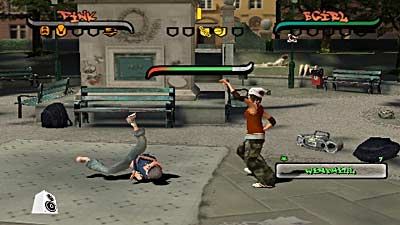
You will receive information about upcoming competitions as well as pointers and other pertinent info on your laptop. Along with the new moves that you accumulate and the tricks and tips, there is a practice mode where you can take these moves out for a test drive. This is very important if you want to do well in the competition, since, as I’ve mentioned, there is a lot of waiting before you get to strut your stuff, so make sure you come prepared or you’re going to get really frustrated really quickly.
An important part of your arsenal is the “movebook” where your various moves are stored for use in competition. You can only take a few moves with you into battle, which I find to be very liberating since it forces you to make the best of a limited move set. This sure beats having to memorize a plethora of button commands and combos. Some may argue that it limits the depth of the gameplay, but there’s more than enough to keep you challenged without having thousands of combos to keep track of. There is no way to customize moves, but there are many ways to link them together during a 45-minute routine to keep things fresh.
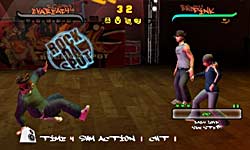
With another cartridge, you can challenge another gamer to a showdown. The multiplayer mode will only accommodate one other player. You would think that, being turn-based, you could just pass-and-play, but keep in mind that you and your challengers will have various moves stored in the movebook, in addition to other customizable options.
Motion-captured moves are fluid and well-rendered. There is a certain “street” style to the game that is sure to give it “cred” with homies and breaker enthusiasts. Character models are cliché in both looks and attitude. The backgrounds are decent but not overly ambitious. It’s actually more impressive than the PS2 graphics, but that’s largely due to lowered expectations. The soundtrack is varied and has a lot of great tunes that transcend the uninspired pap that passes for hip hop these days. How can you go wrong when James Brown and Kool and the Gang are in the house? If you want to capture all the nuances of the tunes, it’s advisable to use headphones, but even with the PSP’s speakers, you can still hear the beat and vocals clearly.
B-Boy has a lot going for it, but it’s not for everyone. The gameplay is limited and there are some technical flaws here and there, including the control system, which is more awkward to use than the PS2 version, since there’s a tendency to move the screen around too much. If you’re thinking of renting this, you’re not going to master it in an afternoon, so be patient. Now get out there and break a virtual leg.
RATING OUT OF 5 RATING DESCRIPTION 4.0 Graphics
Character animations are very fluid. An overall cohesive sense of style to the visuals. 3.0 Control
Simplified set of moves to work with in each competition. Some delay in processing. 3.8 Music / Sound FX / Voice Acting
Cliché voiceovers. There is a decent music mix with the inclusion of R&B tunes. 2.8 Play Value
Good for the novelty factor, but limited mass appeal. 3.1 Overall Rating – Fair
Not an average. See Rating legend above for a final score breakdown.
Game Features:
